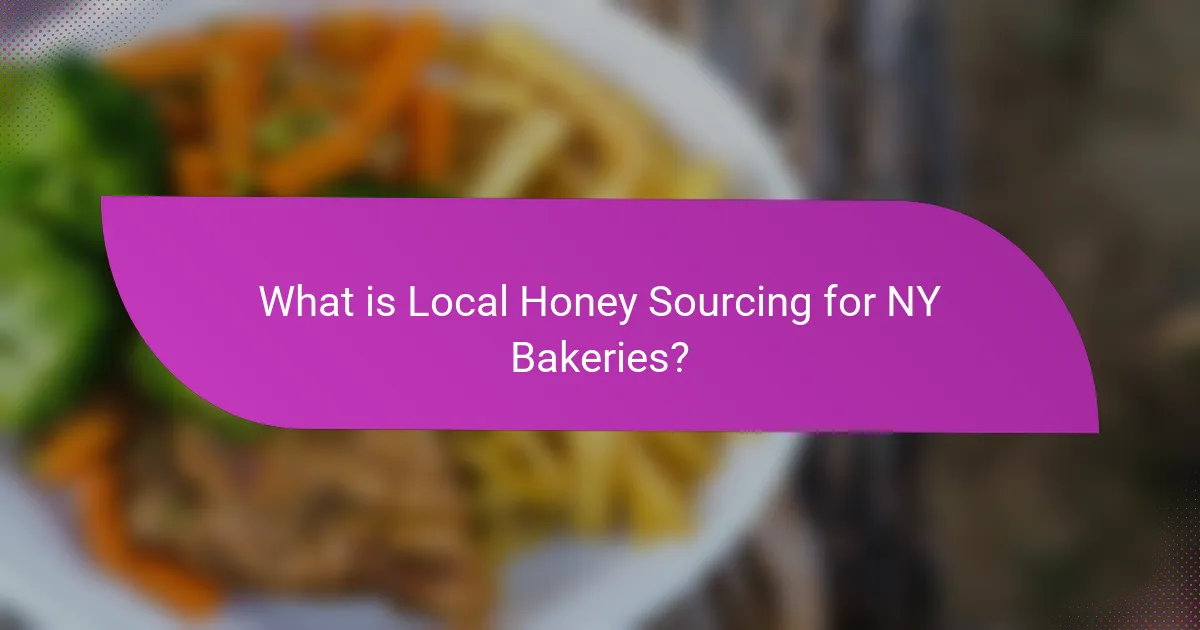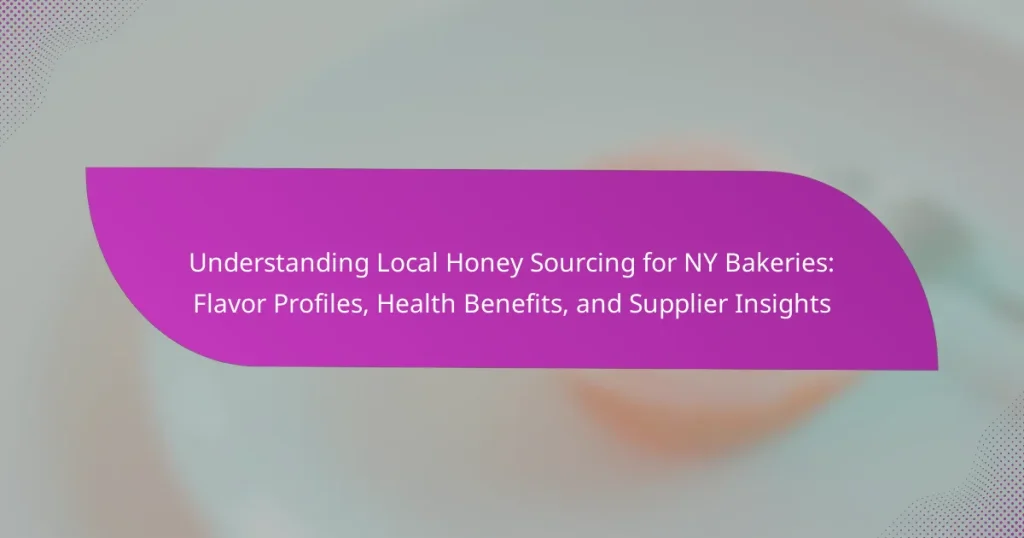Local honey is a key ingredient for New York bakeries, sourced from bees in the surrounding area, supporting local beekeepers and promoting sustainability. This honey not only enhances the flavor of baked goods with diverse profiles, influenced by regional flora, but also offers health benefits, such as potential relief from allergies and antimicrobial properties. Key suppliers like New York City Honey Co., Bee Raw, and Catskill Honey provide a variety of honey types, ensuring freshness and unique characteristics that reflect the local environment. The article explores the significance of local honey sourcing, its flavor profiles, health advantages, and insights into reputable suppliers in New York.

What is Local Honey Sourcing for NY Bakeries?
Local honey sourcing for NY bakeries involves obtaining honey produced by bees in the local area. This practice supports regional beekeepers and promotes sustainability. Local honey is often fresher and can enhance the flavor of baked goods. It may also provide health benefits, such as local pollen exposure, which can help with allergies. Many bakeries prioritize local sourcing to create unique flavor profiles that reflect their community. The use of local honey can also attract customers who value local and artisanal products. Studies show that local honey retains distinct characteristics based on the flora of the region, making it a valuable ingredient for bakers.
How is local honey sourced for bakeries in New York?
Local honey for bakeries in New York is sourced from local beekeepers. These beekeepers maintain hives within the region, allowing for the production of honey that reflects the local flora. Bakeries often establish direct relationships with these beekeepers to ensure quality and freshness. The honey is harvested during peak flowering seasons, typically in late spring and summer.
Sourcing local honey supports local agriculture and promotes sustainability. Many bakeries prioritize raw, unfiltered honey for its natural properties and unique flavor profiles. This honey is then used in various baked goods, enhancing taste and providing health benefits. The practice of sourcing locally also helps reduce transportation emissions, aligning with eco-friendly initiatives.
What are the key characteristics of local honey?
Local honey is characterized by its unique flavor, local floral sources, and potential health benefits. The flavor profile varies based on the types of flowers visited by bees in the area. Local honey often contains pollen from these flowers, which may help with allergies. It is typically unprocessed, preserving its natural enzymes and nutrients. The color of local honey can range from light to dark, influenced by the nectar source. Local honey is also known for its thicker consistency compared to commercial honey. It is often produced in small batches, ensuring freshness and quality. Studies suggest that local honey retains more antioxidants and beneficial compounds than processed varieties.
How does the sourcing process impact honey quality?
The sourcing process significantly impacts honey quality. High-quality honey originates from specific floral sources and regions. These factors influence the flavor, aroma, and color of the honey. Local sourcing allows for fresher product delivery, preserving its natural properties. Additionally, ethical sourcing practices ensure that the bees are healthy and well-cared for. This can enhance the honey’s flavor profile and nutritional benefits. Studies show that honey from diverse floral sources has a richer taste and higher antioxidant levels. Thus, the sourcing process is crucial for maintaining and enhancing honey quality.
Why is local honey important for NY bakeries?
Local honey is important for NY bakeries because it enhances flavor and supports local agriculture. Using local honey provides unique taste profiles that reflect the region’s floral diversity. This can differentiate baked goods in a competitive market. Additionally, local honey contains beneficial enzymes and antioxidants. These health benefits appeal to health-conscious consumers. Supporting local beekeepers fosters community relationships and sustainability. It helps maintain bee populations, which are crucial for pollination. Local honey also aligns with the farm-to-table movement, attracting customers who value local sourcing.
What unique flavors does local honey bring to baked goods?
Local honey introduces distinct flavors to baked goods. These flavors vary based on the floral sources available in the region. For example, honey from clover blossoms tends to be mild and sweet. In contrast, honey derived from wildflowers may offer a more complex taste profile. Additionally, honey from fruit trees can impart fruity notes to baked items. The unique terroir of local honey enhances the overall flavor experience. This characteristic makes it a preferred ingredient among bakers. Studies show that local honey can elevate the taste of items like bread and pastries significantly.
How does local honey contribute to the local economy?
Local honey contributes to the local economy by supporting local beekeepers and agricultural practices. It creates jobs in beekeeping, honey production, and distribution. Local honey sales keep money within the community, boosting local businesses. According to the USDA, honey production in the U.S. was valued at over $300 million in 2020. Additionally, local honey promotes pollination, benefiting local crops and enhancing agricultural yields. This interconnectedness helps sustain the local farming ecosystem. As a result, the economic impact of local honey extends beyond just sales, fostering community resilience and sustainability.

What are the Flavor Profiles of Local Honey?
Local honey exhibits diverse flavor profiles influenced by the floral sources visited by bees. These profiles can range from floral and fruity to earthy and spicy. For instance, clover honey is typically mild and sweet, while wildflower honey can present a complex mix of flavors. The region’s climate and soil also affect the honey’s taste. In New York, local honey may have unique characteristics due to the variety of plants available. Studies show that honey’s flavor can change with the season, reflecting the blooming patterns of local flora. This variability makes local honey particularly appealing for bakers seeking distinctive flavors.
How do different floral sources affect honey flavor?
Different floral sources significantly affect honey flavor. Each type of flower contributes unique compounds to the honey. For example, clover honey has a mild, sweet taste. In contrast, buckwheat honey offers a robust, earthy flavor. The specific nectar composition influences the aroma and taste profile. Honey from citrus blossoms tends to be light and fruity. Conversely, honey derived from wildflowers can have complex, varied flavors. The geographical location also plays a role in the flavor, as local flora directly impacts the honey’s characteristics. Studies have shown that honey flavor can be linked to specific floral sources, confirming the relationship between nectar origin and taste.
What are the common floral sources for honey in New York?
Common floral sources for honey in New York include clover, wildflowers, and fruit trees. Clover is abundant and provides a light, sweet flavor. Wildflowers contribute diverse tastes depending on the season. Fruit trees, such as apple and cherry, enhance honey’s fruity notes. These sources reflect the region’s varied flora. Research indicates that local honey’s flavor is influenced by these floral sources, making it unique to New York.
How can bakers select honey based on flavor profiles?
Bakers can select honey based on flavor profiles by tasting different varieties and identifying their distinct flavors. Each type of honey has a unique taste influenced by the flowers visited by the bees. For example, clover honey is mild and sweet, while buckwheat honey has a robust, earthy flavor. Bakers should consider the intended use of honey in their recipes. Floral notes may complement pastries, while stronger flavors can enhance bread. Additionally, local honey often reflects regional flora, providing unique flavor characteristics. By sampling honey from local suppliers, bakers can find the best match for their specific needs. This approach ensures that the flavor profile aligns with the overall taste of the baked goods.
What role does honey flavor play in baking?
Honey flavor enhances baked goods by providing natural sweetness and a unique taste profile. It contributes moisture and tenderness to recipes, improving texture. Honey also promotes browning, which adds visual appeal and depth of flavor. The distinct floral notes of honey can complement various ingredients, creating complex flavor combinations. Additionally, honey has natural preservative qualities, extending shelf life. Studies show that honey can replace refined sugars in recipes, offering a healthier alternative. Its versatility makes honey a valuable ingredient in baking.
How can bakers enhance their recipes with local honey?
Bakers can enhance their recipes with local honey by substituting it for refined sugars. Local honey adds unique flavor profiles that vary by region and season. This natural sweetener also retains moisture, improving the texture of baked goods. Honey can enhance the browning of crusts due to its fructose content. Additionally, local honey offers potential health benefits, such as antioxidants and local pollen exposure. Studies show that honey can have a lower glycemic index compared to sugar, making it a healthier choice. Using local honey supports local beekeepers and promotes sustainable practices.
What are the taste differences between local and commercial honey?
Local honey typically has a more complex flavor profile compared to commercial honey. Local honey often reflects the specific flora of the region where it is produced. This results in unique taste notes that can vary significantly based on seasonal blooms. In contrast, commercial honey is usually blended from various sources, leading to a more uniform and less distinctive taste. The processing methods for commercial honey can strip away some of the natural flavors. Additionally, local honey may contain trace amounts of pollen, contributing to its flavor and potential health benefits. Studies indicate that local honey can enhance the taste experience due to its diverse floral sources.

What are the Health Benefits of Local Honey?
Local honey offers several health benefits. It is known for its potential to alleviate allergies. Consuming local honey may help the body acclimate to local pollen. This can lead to a reduction in allergy symptoms over time. Local honey also possesses antimicrobial properties. Studies show that honey can inhibit the growth of certain bacteria. Furthermore, it may aid in wound healing due to its natural antibacterial effects. Local honey is also a natural source of antioxidants. Antioxidants help combat oxidative stress in the body. Additionally, it can provide a quick energy boost due to its natural sugars. These benefits make local honey a valuable addition to a healthy diet.
How does local honey benefit health and wellness?
Local honey offers several health and wellness benefits. It acts as a natural sweetener with lower glycemic index than refined sugar. This means it can help regulate blood sugar levels. Local honey also contains antioxidants that may support heart health. Additionally, it has antibacterial properties that can aid in wound healing. Consuming local honey may also help alleviate seasonal allergies by exposing the body to local pollen. Research indicates that local honey can improve digestive health due to its prebiotic content. These attributes make local honey a valuable addition to a healthy diet.
What specific nutrients are found in local honey?
Local honey contains various specific nutrients. These include carbohydrates, primarily in the form of fructose and glucose. It also contains vitamins such as B vitamins, including niacin, riboflavin, and pantothenic acid. Additionally, local honey has minerals like calcium, potassium, magnesium, and phosphorus. Antioxidants are present, contributing to its health benefits. The exact nutrient composition can vary based on floral sources and local conditions. Studies have shown that the antioxidant levels in honey can help combat oxidative stress. This nutrient profile supports the use of local honey in baking and health applications.
How does local honey support local immunity?
Local honey supports local immunity by providing exposure to local pollen and allergens. This exposure helps the immune system build tolerance to these allergens. Local honey contains antioxidants, which can strengthen the immune response. Studies show that antioxidants combat oxidative stress, enhancing overall health. Additionally, local honey has antibacterial properties, which can help fight infections. The presence of enzymes in honey contributes to its health benefits. Consuming local honey may reduce seasonal allergies, as it introduces small amounts of local pollen. This gradual exposure can lead to fewer allergic reactions over time.
What are the common misconceptions about honey’s health benefits?
Common misconceptions about honey’s health benefits include the belief that all honey is equally beneficial. In reality, the health benefits vary significantly between types of honey. Some people think that honey can replace all medications. However, honey should complement, not substitute, medical treatments. Another misconception is that honey is a low-calorie sweetener. In fact, honey contains about 64 calories per tablespoon, similar to sugar. Many believe that raw honey has no allergens. Yet, some individuals may still react to pollen particles present in raw honey. Lastly, some think honey can cure all ailments. While honey has antibacterial properties, it is not a cure-all solution. These misconceptions can lead to misunderstandings about honey’s actual health benefits.
How does the processing of honey affect its health properties?
Processing honey can significantly alter its health properties. Raw honey retains enzymes, antioxidants, and nutrients that can be diminished during processing. Heating honey can destroy beneficial enzymes like diastase and invertase, which aid in digestion. Additionally, pasteurization can reduce the antioxidant levels in honey. Studies show that raw honey has higher phenolic content compared to processed honey. The filtration process removes pollen, which can also reduce the health benefits associated with local honey. Therefore, minimally processed or raw honey is generally considered healthier than heavily processed varieties.

Who are the Key Suppliers of Local Honey for NY Bakeries?
Key suppliers of local honey for NY bakeries include the New York City Honey Co., Bee Raw, and Catskill Honey. These suppliers are known for sourcing honey from local beekeepers. They provide a variety of honey types, including wildflower and clover honey. The New York City Honey Co. focuses on urban beekeeping, ensuring fresh local products. Bee Raw emphasizes raw, unfiltered honey, preserving natural flavors. Catskill Honey sources from the Catskill region, known for its diverse floral sources. Their products are popular among bakers for unique flavor profiles.
How can bakeries find reliable local honey suppliers?
Bakeries can find reliable local honey suppliers by researching local beekeepers and honey producers. They can start by visiting farmers’ markets where local honey is often sold. Additionally, bakeries can join local agricultural associations or groups focused on beekeeping. Networking with other local businesses may also provide referrals to trustworthy suppliers. Online platforms like local food directories can help identify nearby honey producers. Checking reviews and ratings of suppliers can ensure their reliability. Finally, establishing direct communication with beekeepers can help verify their practices and product quality.
What factors should be considered when choosing a honey supplier?
When choosing a honey supplier, consider the source of the honey. Local sourcing ensures freshness and supports regional beekeepers. Evaluate the honey’s quality and purity, checking for certifications like organic or raw. Assess the supplier’s production practices, including ethical treatment of bees and sustainable harvesting methods. Examine the range of honey varieties offered, as different flowers yield distinct flavors. Look into pricing and minimum order quantities to align with your budget. Finally, review customer service and delivery reliability to ensure a smooth purchasing experience.
How can bakeries build relationships with local beekeepers?
Bakeries can build relationships with local beekeepers by collaborating on sourcing honey. Establishing direct communication is essential. Bakeries should reach out to local beekeepers through community events or farmers’ markets. Offering to feature their honey in baked goods creates mutual benefits. Joint promotional efforts can enhance visibility for both parties. Sharing knowledge about honey’s flavor profiles can strengthen the partnership. Regular meetings can help align goals and expectations. Supporting beekeepers through purchasing commitments fosters long-term relationships.
What are the best practices for sourcing local honey?
The best practices for sourcing local honey include identifying local beekeepers and evaluating their practices. Research local farmers’ markets and agricultural fairs to find reputable honey producers. Verify that the honey is raw and unprocessed for maximum flavor and health benefits. Check for local certifications or memberships in beekeeping associations. Engage with beekeepers to understand their sourcing methods and hive management. Ensure that the honey is sourced sustainably to support local ecosystems. Consider the floral sources of the honey to match flavor profiles desired for bakery products. Lastly, sample different varieties to assess quality and taste before making bulk purchases.
How can bakeries ensure quality and sustainability in their honey sourcing?
Bakeries can ensure quality and sustainability in their honey sourcing by selecting local, organic honey suppliers. Local honey is often fresher and retains more nutrients. Organic certification indicates that the honey is produced without harmful chemicals. Establishing relationships with local beekeepers fosters transparency in sourcing practices. Regular quality checks on honey batches help maintain high standards. Supporting sustainable beekeeping practices protects bee populations and ecosystems. Research indicates that local honey can enhance flavor profiles in baked goods. Additionally, consumer preferences increasingly favor sustainably sourced ingredients.
Local honey sourcing for NY bakeries involves obtaining honey from local beekeepers, which supports sustainability and enhances the flavor of baked goods. The article covers the characteristics of local honey, including its unique flavor profiles influenced by regional flora, and highlights its health benefits, such as allergy relief and antioxidant properties. Additionally, it examines the sourcing process, the importance of local honey for the economy, and best practices for bakeries in selecting reliable suppliers while promoting ethical and sustainable practices. Overall, the article provides insights into how local honey can elevate the quality and appeal of bakery products.




